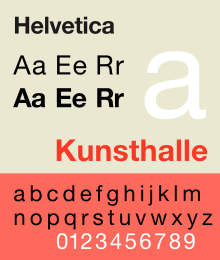
Back هيلفيتيكا Arabic Helvetika Azerbaijani Helvetica Catalan Helvetica Czech Helvetica Danish Helvetica (Schriftart) German Helvetica Esperanto Helvetica Spanish Helvetica Basque Helvetica Finnish
 | |
| Category | Sans-serif |
|---|---|
| Classification | Neo-grotesque[1] |
| Designer(s) | Max Miedinger Eduard Hoffmann |
| Foundry | Haas'sche Schriftgiesserei (Basel) |
| Date released | 1957 |
| Re-issuing foundries | Mergenthaler Linotype Company |
| Design based on | Akzidenz-Grotesk |
| Variations | Helvetica Inserat Helvetica Compressed Neue Helvetica Helvetica Now Others (see below) |
| Also known as | Neue Haas Grotesk |
| Shown here | Neue Helvetica |
| Metrically compatible with | |
Helvetica, also known by its original name Neue Haas Grotesk, is a widely used sans-serif typeface developed in 1957 by Swiss typeface designer Max Miedinger and Eduard Hoffmann.
Helvetica is a neo-grotesque design, one influenced by the famous 19th-century (1890s) typeface Akzidenz-Grotesk and other German and Swiss designs.[2] Its use became a hallmark of the International Typographic Style that emerged from the work of Swiss designers in the 1950s and 1960s, becoming one of the most popular typefaces of the mid-20th century.[3] Over the years, a wide range of variants have been released in different weights, widths, and sizes, as well as matching designs for a range of non-Latin alphabets. Notable features of Helvetica as originally designed include a high x-height, the termination of strokes on horizontal or vertical lines and an unusually tight spacing between letters, which combine to give it a dense, solid appearance.
Developed by the Haas'sche Schriftgiesserei (Haas Type Foundry) of Münchenstein (Basel), Switzerland, its release was planned to match a trend: a resurgence of interest in turn-of-the-century "grotesque" sans-serifs among European graphic designers, that also saw the release of Univers by Adrian Frutiger the same year.[4][5][6] Hoffmann was the president of the Haas Type Foundry, while Miedinger was a freelance graphic designer who had formerly worked as a Haas salesman and designer.[7]
Miedinger and Hoffmann set out to create a neutral typeface that had great clarity, had no intrinsic meaning in its form, and could be used on a wide variety of signage.[7] Originally named Neue Haas Grotesk (New Haas Grotesque), it was rapidly licensed by Linotype and renamed Helvetica in 1960, which in Latin means "Swiss", from Helvetia, capitalising on Switzerland's reputation as a centre of ultra-modern graphic design.[8] A feature-length film directed by Gary Hustwit was released in 2007 to coincide with the 50th anniversary of the typeface's introduction in 1957.[9]
- ^ Kupferschmid, Indra. "Combining Type With Helvetica". FontShop (archived). Archived from the original on 30 April 2010. Retrieved 29 April 2018.
- ^ Berry, John. "A Neo-Grotesque Heritage". Adobe Systems. Archived from the original on 16 October 2015. Retrieved 15 October 2015.
- ^ Shinn, Nick (2003). "The Face of Uniformity" (PDF). Graphic Exchange. Archived from the original (PDF) on 18 November 2016. Retrieved 18 July 2022.
- ^ Kupferschmid, Indra (14 October 2014). "I had never loved Helvetica". Archived from the original on 25 October 2018. Retrieved 5 October 2015.
- ^ Gerstner, Karl (1963). "A new basis for the old Akzidenz-Grotesk (English translation by Forgotten Shapes)" (PDF). Der Druckspiegel. Archived from the original (PDF) on 2017-10-15. Retrieved 15 October 2017.
- ^ Gerstner, Karl (1963). "Die alte Akzidenz-Grotesk auf neuer Basis" (PDF). Der Druckspiegel. Archived from the original (PDF) on 2017-10-15. Retrieved 15 October 2017.
- ^ a b Helvetica (Documentary). 2007-09-12.
- ^ Shaw, Paul. "Helvetica and Univers addendum". Blue Pencil. Archived from the original on 24 September 2015. Retrieved 1 July 2015.
- ^ Shaw, Paul. "The Univers of Helvetica: A Tale of Two Typefaces". Print. Archived from the original on 17 September 2019. Retrieved 26 June 2016.
© MMXXIII Rich X Search. We shall prevail. All rights reserved. Rich X Search